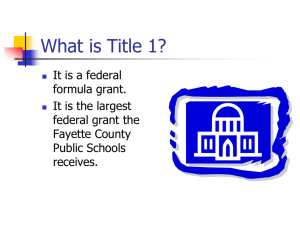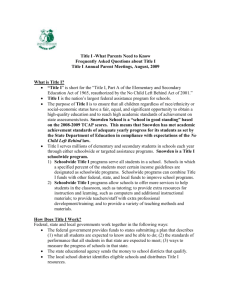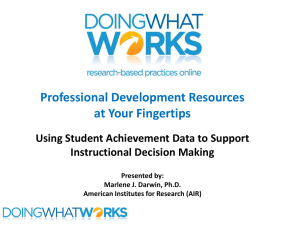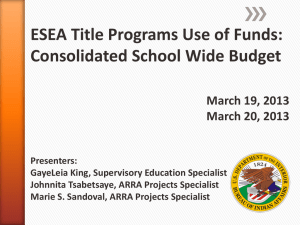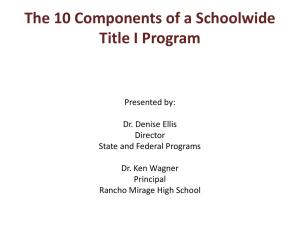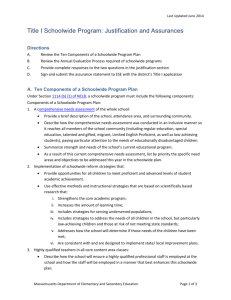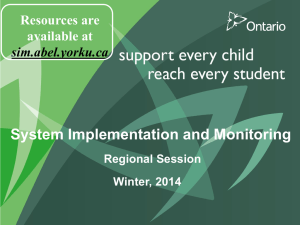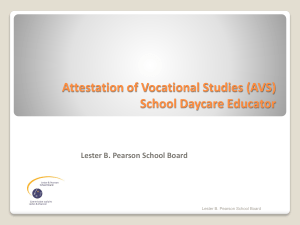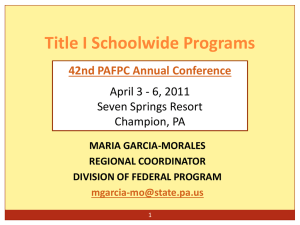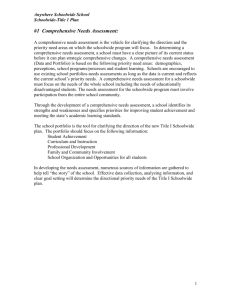4560AEAF784DD8905B2480007D54DE0F
advertisement
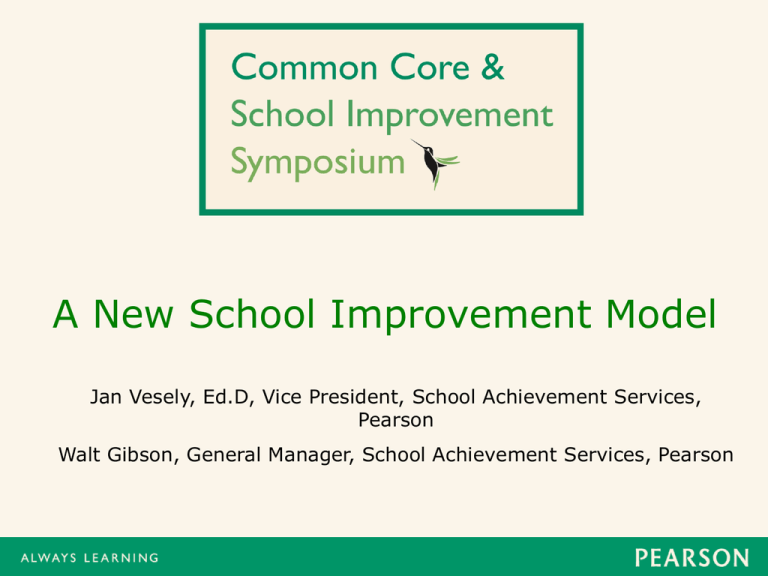
A New School Improvement Model Jan Vesely, Ed.D, Vice President, School Achievement Services, Pearson Walt Gibson, General Manager, School Achievement Services, Pearson Building SIM – What the research says about school turnaround: Turning a school around requires a comprehensive approach Turnaround requires an external Lead Partner who deeply embeds support within the school (MassInsight Report, Calkins et al., 2007) One size does NOT fit all! – Strategies must be comprehensive, flexible, adaptable, and sustainable (Brookings Institute, 2002; Century, (MassInsight Turnaround Report, Calkins et al., 2007; Bryk et al.2010) 2009; Center on Education Policy, 2009) Turnaround requires dramatic academic and non academic change (MassInsight Turnaround Report, Calkins et al., 2007) Fidelity of Implementation matters (Borman et al., 2003) Districts must support the change with system-wide commitment, effective professional development, and a plan for sustainability. (Supovitz, 2007) Pearson Schoolwide Improvement Model (SIM) Comprehensive Flexible Evidence-based Affordable Sustainable SIMply results Prepare your students to be college and career ready Help your students achieve the Common Core Provide high quality instruction for all students Reach every student, every subject, every year Implement a data-driven approach Provide academic support beyond the school day In literacy, the Common Core State Standards: Dramatically increase text complexity at every grade level – “The ability to read and comprehend complex text is the best predictor of college success.” Emphasize informational text at ever-increasing levels across the grades Require increasingly complex academic vocabulary Are measured by students’ ability to reason and justify an argument Will assess students’ literacy in both science and social studies Are aligned to the expectations for entering college or the workforce without remediation In math, the Common Core State Standards: Are organized, K to 12, around key topics in mathematics Emphasize focus and coherence • Focus on key topics at each grade level. • Define coherent progressions across grade levels. Balance concepts and skills Require both conceptual understanding and procedural fluency Foster reasoning and sense-making in mathematics. Are aligned to the expectations for entering college or the workforce without remediation Schoolwide Improvement Model (SIM) Why will it work in Hawaii? The Pearson Schoolwide Improvement Model: Can stand on its own as an effective and comprehensive solution • Is custom-designed for each grade span • Can bring a schoolwide focus to disparate programs and initiatives • Can serve as a single school model — does not depend on a cohort • Does not depend on having coaches • Is repeatable so it can be researched • Is not dependent on on-site professional development • SIM may be flexed in two ways: • Through optional additions, such as math and literacy interventions • By varying the intensity of support for implementation Schoolwide Instructional Focus Professional Development for all teachers Emphasis on Academic Language Reasoning and Justification Collaboration Independent Learning Content Area Concentrations English language arts Mathematics Implementation Elements Highly focused Leadership Team with distributed responsibilities Leadership Team responsible for: Driving implementation process, including workgroup facilitation; building tight linkages among settings Assuring school organization and support for implementation goals Systematic monitoring of implementation and adjusting plans and strategies to address improvement needs Component 3: Data-Driven Culture Implementation Elements Ties Standards-Aligned Curriculum, Instruction, and Assessment together with High Performance Leadership, Management, and Organization Systematic development of foundations for establishing school as data-driven culture, linking leadership, departments, classrooms, counseling & guidance • Student achievement data • Non-academic student data • Schoolwide systems data • Classroom observation data Component 4: High Achievement and Engagement Implementation Elements Ties Aligned Curriculum, Instruction, and Assessment together with High Performance Leadership, Management, and Organization Focus on: • Engaging community in supporting high expectations • Connecting classroom culture of engagement to school culture of high expectations and support for achievement • Instituting early warning system connected to tiered supports for students’ social and emotional development Student Services staff (including deans, counselors, social workers) form High Achievement and Engagement Workgroup for maintain continuing focus Component 5: Building Capacity for Sustainability Implementation Elements Coherent school-wide approach to curriculum, instruction and assessment Development of instructional leadership and distributed leadership with tight linkages to Aligned Instruction Systems development • Data-driven culture • Early warning system with guidance on connected tiered supports Connected system of Professional Development and Technical Assistance with support from Learning Teams Monitoring and feedback protocols and resources coupled with systematic processes for monitoring and adjusting plans School drives implementation from the beginning with: Scaffolded support provided by the design of the Model On site technical assistance by Pearson Field Specialists Pearson Schoolwide Improvement Model Deliverables for Hawaii Experienced, Embedded Local Team 60 days of on-site leadership, literacy, and mathematics assistance from highly-qualified and certified Pearson field specialists 10 days of Common Core professional development focused on: Tier 1 instructional practices (Schoolwide Instructional Focus) Leadership training, Learning Teams training, and CCSS curriculum alignment Ongoing implementation support from Pearson’s National College for professional development and research Pearson Schoolwide Improvement Model Deliverables for Hawaii Robust tools for teachers, students, and parents Galileo K-12 Online Comprehensive Assessment Teacher Compass and Principal Compass Cloud based teacher and principal enlightenment tools delivered via web or iPad Developed at Johns Hopkins University to collect and aggregate observation data, track schoolwide trends, and support self assessment and professional learning Built in feedback systems, social collaboration platform, and extensive library of 3,000+ professional development videos At-Risk/Drop-out Prevention online monitoring tool SmartThinking 24/7 online tutoring for students Optional Digital and print tools available for student interventions Pearson Schoolwide Improvement Model Deliverables for Hawaii A Solid Research-Based Model Aligns curriculum, instruction, and assessment Prepares teachers and students for transition to the common core Provides an instructional focus emphasizing academic language and independent learner competencies Promotes Tier 1 instruction in every classroom through Systematic teacher development, Skilled technical assistance, and Coaching from embedded Pearson staff Expands classroom engagement to a culture of high expectations Incorporates Learning Teams to establish regular settings for process-driven instructional collaboration and a data-driven approach to improvement Includes SIOP support for ELL’s and additional support for special education students Headlines of the SIM 1 Quality first instruction for all Schoolwide instructional focus on college & career readiness Complementary focus on students’ social & emotional readiness Practical strategies for aligning curriculum & instruction to standards & assessments Tight linkages between development settings — leadership, departments, classrooms, counseling & guidance Capacity building for sustainability from Day One Job-embedded professional development with online support Onsite support from certified Field Specialists as needed Model can be flexed to meet school needs Customer Engagement ProcessProcess Customer Engagement Pre-Contract Engagement Qualification Sales Sales Requirements Conference Sales Sales GM GM Field Designee Field Designee SIM Implementation Planning Conference Sales Sales GM GM Field Designee Field Designee Field Field Specialist Specialist Principal Principal Assoc. Assoc. Principals Principals Deans Deans & small group & small group including the including the scheduler and scheduler and counselor counselor Launch Institute Continuing Implementation •Pearson General General Manager, Manager, West •Pearson West •Assigned Project Manager •Assigned Project Manager •Content Area Field Specialists •Content Area Field Specialists •National Training Staff •National Training Staff • Principal. AP’s and Deans • Principal. AP’s and Deans •School Leadership Team •School Leadership Team •Key Content Area leaders •Key Content Area leaders •School Support Staff •School Support Staff SIMply results. SIMply results. Pearson’s Schoolwide Improvement Model (SIM) is an innovative standards-based system of comprehensive school improvement. Forged in collaborative partnerships with more than a thousand schools, SIM represents the culmination of two decades worth of verifiable third-party research, experience and…simply…results. Flexible and affordable, SIM meets the unique needs of any individual school or group of schools, helping you help all students become college and career ready. Through a data-driven, technology-supported, customizable process, SIM helps you turn the complexities of school improvement into sustainable results. www.pearsonschoolimprovement.com
